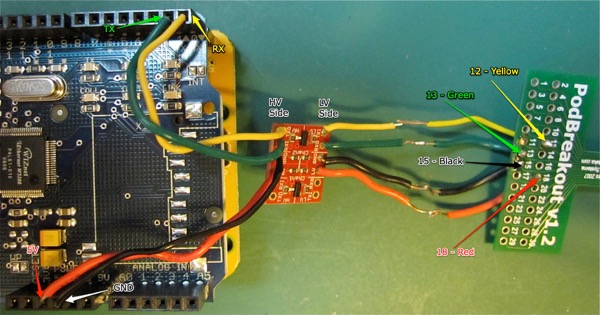iPod Remote Part Deux
4/14/2010 UPDATE: See here if you have a v1.4 PodBreakout board.
I had been using my iPod remote for a few months. It worked well and scratched the itch it was built to scratch. But in December I got a new car with iPod and Bluetooth integration. I also got rid of my despised Blackberry and switched to an iPhone. This meant I no longer needed to use my custom remote, so I placed it lovingly in my electronics drawer and forgot about it for a while.
Recently I was asked if I would present a talk at Make: PGH about my experiences developing my Arduino iPod Serial library. I agreed, and it’s tentatively scheduled for the April meet-up. Someone also sent me an email asking for some help troubleshooting their build of a remote, so I was inspired to dig the remote out of the drawer. I also took a look at the library I’d created and decided that I really ought to finish what I’d started.
I already had a spare logic-level converter and PodGizmo from the original project, so I soldered them together and hooked them up to my Mega. (The Mega is great for testing serial protocol stuff because it has four real serial ports, compared to the one on a regular Arduino. I built the library with debug hooks in it so that I could spit out the protocol data going back and forth between the iPod and the Arduino, and without that it would have been really hard to debug it.)
I discovered that the resistor connected to pin 21 isn’t needed. I also realized that I could use the iPod to supply the low-voltage power to the logic-level converter. This cleaned up the wiring considerably (click on the image to go to Flickr where there’s a full-resolution version):

On the left is a Freeduino with an Ethernet Shield on top of it, but more on that later - the point is that you just need 5V, Ground and your Serial TX/RX lines on the Arduino side. The awful connections in the four wires between the logic-level converter and the PodBreakout board shouldn’t be there. They only exist because I tried out the suggestion here to skip the logic-level converter and put a 1KOhm resistor between the Arduino TX pin and the iPod RX pin. I verified with an EE friend that this would be okay and he said:
While not optimal, you should never see a problem with a 1k resistor. On TX_ARDUINO... (not RX_ARDUINO). What you're doing is relying on the protection diode of the iPhone to clamp the Voltage and sink some current. The resistor will do two things. 1) Limit the current possible to send into the iPhone (5V / 1k = 5mA max). Almost all digital protection circuits can handle 5mA for a few minutes at least. Therefore, even if you wire it up wrong, you will be very unlikely to fry anything. 2) Provide somewhere besides the protection diode in the iPhone to dissipate the power (V^2/R = 1.7*1.7/ 1k = 2.89 mW). 3mW isn't a lot of power for a diode, but it will help prevent the chip from wearing out prematurely.
Vih on the ATmega328 (Duemilanove) is 0.6*Vcc when Vcc is 5.0V. This means that the input signal needs to be above 3.0V to be guaranteed to be seen as a "1". There's usually a bit of guard-band on that spec. However, I would NOT put a resistor on the iPhone output to the Arduino (RX_ARDUINO). If you did, you'd start to see bit errors at higher bit rates. At 9600 baud, you shouldn't see anything unpleasant on either side of the bus.
As he said, it didn’t do any harm to my iPod, but unfortunately I was unable to get any communication to work using this method. I tried it a few times, even with just the Play/Pause sketch, which requires no response from the iPod, without luck. It could be that I did something wrong though. The logic-level converters are under $3 so I’m okay with continuing to use them.
Back in September I had two example sketches included in the library: a Simple Remote Mode one that did play/pause, which was what I was using in my car; and a proof-of-concept sketch for Advanced Remote Mode. This went with the just-proof-of-concept Advanced Remote mode support I had implemented. Over the last few weeks I have added full support for Simple Remote Mode, which was pretty easy, and near-full support for Advanced Remote Mode (no picture block support), which was a lot more complicated. I also refactored the library code because it needed to be done, and that sort of thing makes me happy.
I have been adding example sketches as I go, and I will talk about those in follow-up articles.